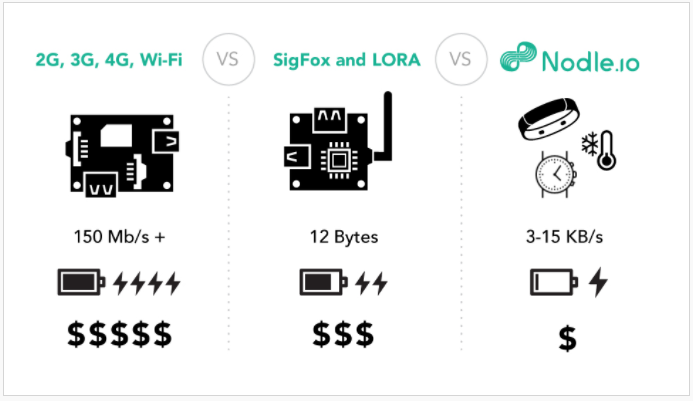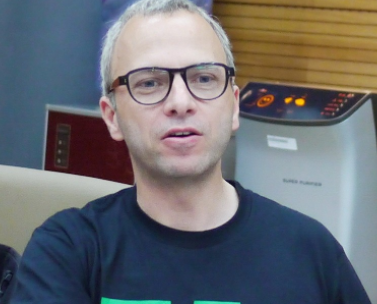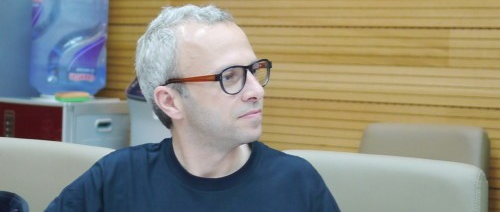 aNewDomain — Maybe you’ve wondered, as I have, about the sad state of Internet of Things networking. I mean, what’s the point of having billions of Internet of Things (IoT) devices out there if they can’t easily and cheaply talk to one another?
aNewDomain — Maybe you’ve wondered, as I have, about the sad state of Internet of Things networking. I mean, what’s the point of having billions of Internet of Things (IoT) devices out there if they can’t easily and cheaply talk to one another?
If so, definitely check out my latest Daily Dozen Q&A with Open Garden founder Micha Benoliel. He’s just recently launched Nodle.io, a new venture and tool that he claims will enable low-cost delay-tolerant networking among IoT devices. And it uses just on-board circuitry and Bluetooth to do it.
I caught up with Benoliel and fired off 12 questions about the company, the tech and where he hopes to take it all. Here’s what he had to say.
GS: This is going to sound strange, but for the longest time I’ve been sort of obsessing over the fact that no one’s yet emerged to become the Cisco of IoT. Not even Cisco. No one’s come up with a good easy way to network these things.
Micha Benoliel: Well, that’s what we are building with Nodle. The thing is to build an open wide area network (WAN) that’s inexpensive … and global. Nodle is focused on connecting devices. We want to make the IoT a reality and lower the barriers to entry to see more innovations happening from device makers.
[mks_button size=”large” title=”READ Richard Feynman, Dick Davies & Al Higgs: The Late, Great Beat Generation Scientists of JPL” style=”rounded” url=”https://anewdomain.net/richard-davies-last-of-the-great-beat-generation-scientists/” target=”_blank” bg_color=”#1e73be” txt_color=”#FFFFFF” icon=”fa-th-large” icon_type=”fa” nofollow=”0″]
GS: There’s been a need for this for at least two years. I know that low-power WAN efforts like LoRA have tried, but they require additional hardware. Yours is all software. Why did it take so long for someone to do this?
Benoliel: There needed to be some elements in place first. Yes, you had this increasing multitude of devices and sensors out there to connect and transmit information. But the cost of hardware like radio chipsets had to come down to the right level — and now that can go for as close to $1. You also needed computer and AI systems that USE real life data to make decisions or interactions in real time. That’s all here now.
GS: And you’re using Bluetooth. Was that the key right there all along?
Benoliel: Well, it’s a market trend. Bluetooth is already accounting for 30 percent of all IoT devices and the trend is towards reaching adoption on 50 percent of all IoT devices. The standard itself is evolving into something that is more and more relevant for this. Bluetooth Low Energy (Smart) was a leap in how the protocol could be used. Bluetooth 5 augments that potential. Then the next big leap will be Bluetooth Mesh.
[mks_pullquote align=”left” width=”300″ size=”18″ bg_color=”#000000″ txt_color=”#ffffff”]To send data back to their cloud, IoT device makers don’t need to make any changes to their existing hardware and firmware. The Nodle platform adapts automatically to the structure of the data.[/mks_pullquote]
GS: Ah, mesh. Lots of our readers are going to recognize you as the guy who founded Open Garden. And I wanted to ask you that. I realize Nodle’s not a mesh networking play like Open Garden, but what’s the thread that led you from that to this?
[mks_button size=”large” title=”READ Daily Dozen: 12 Questions for ‘Father of the Internet,’ Vint Cerf” style=”rounded” url=”https://anewdomain.net/daily-dozen-12-questions-vint-cerf-father-internet/” target=”_blank” bg_color=”#1e73be” txt_color=”#FFFFFF” icon=”fa-th-large” icon_type=”fa” nofollow=”0″]
Benoliel: I learned that it’s hard to create the best utility if you only have your own users to rely on. When you build hardware, you might sell a million of your devices, but the active user base for any given mobile application linked up to it could end up to being just a tenth of that number. So it became clear to me that what I needed was a new networking layer altogether. And it had to be global and easy to access.
 GS: That’s an ambitious goal, which I love. But that means everyone in the universe has got to support it. And you have an SDK. Is succeeding here just a matter of signing up a critical mass of partners to write for this before anyone else starts competing with another solution?
GS: That’s an ambitious goal, which I love. But that means everyone in the universe has got to support it. And you have an SDK. Is succeeding here just a matter of signing up a critical mass of partners to write for this before anyone else starts competing with another solution?
Benoliel: We’re focusing on particular geographies and use cases first. We are preparing to run POCs with local telcos and device makers. As we grow the network will become global.
Also, to send data back to their cloud, device makers don’t need to make any changes to their existing hardware and firmware. Our platform adapts automatically to the structure of the data. That’s why Nodle is such a powerful tool.
And signing up partners is only one element. Then you need to scale operations, maintain security and integrity in the network while keeping the rate of innovation high. It is a more complex game than what it appears if you want to be the w inner takes all. Timing is really important.
inner takes all. Timing is really important.
GS: Let’s talk about security. It’s a major concern for IoT as it develops …
Benoliel: Security is a top priority. We spend a lot of time educating IoT manufacturers and partners about the best practices to prevent devices from being hacked.
GS: What kind of cases are you giving as examples of what to build first time out?
Benoliel: I like a lot what we are doing with LifeKit in Vietnam. It’s a company that builds healthcare devices that hospitals use to help kids to breath. There is a clear lack of infrastructure (for this) in Vietnam and many other South East Asian countries. So Nodle solves this by leveraging the smartphones of people who are working in hospitals so they can collect the useful data they need to improve the quality of their devices and improve the way they maintain them.
Another obvious use case we like comes out of the partnerships we have in the motion tracking space with MyStilla. Another is our partnership with Trackr for the tracking of assets.
GS: I found it interesting that said you will be “crowdsourcing connectivity” in some of the announcement materials. What is up that? What are the numbers looking like?
Benoliel: No, because we haven’t announced any numbers yet. But as we get to broader reach we’ll start to communicate official numbers on the coverage and SLA.
GS: What’s the rev model here? I’m guessing some kind of a partner revshare, right? Anything else?
Benoliel: It’s all revshare for now. We share our revenues with developers, OEMs and carriers who help us grow the network. [For developers, it] brings a new alternative for revenues. Developers are looking for alternatives to heavy advertising SDKs. And we are also testing a consumer app and in the future people might be able to be rewarded or make money simply by carrying the app or completing simple tasks. It is concept similar to what mining is to some cryptocurrencies.
[mks_pullquote align=”left” width=”300″ size=”18″ bg_color=”#000000″ txt_color=”#ffffff”]My inspirations are more spiritual and metaphysical. I always perceived that all humans and nature are constantly connected to one another and I want to extend that vision to devices and objects around us.[/mks_pullquote]
GS: So in terms of competition, what’s the barrier to entry here?
Benoliel: It is a combination of IP, know-how and strong partnerships, combined with the mission of the company. That focuses on enabling more innovation by lowering the barriers to access a global connectivity layer. We believe we have no direct competition in the way we approach and enter the market. Nonetheless, it is an ultra competitive environment with lots of challenges and a number of technologies that complement and also compete with one another
GS: What could go wrong? In other words, what is the one thing that you know could sink this — that you are already taking steps to make sure doesn’t happen?
Benoliel: Speed of execution combined with the scaling of the network are both very important. They both imply many challenges ranging from attracting the right talents for the company to technically managing gigantic amounts of data.
 GS: People who aren’t in tech are sometimes a little ho-hum when they hear about IoT. They say, well, of course IoT is coming. Just as computer chips came into everything in the 70s, 80s and 90s, this is just an evolution. Nothing to get excited about. What would you tell them they’re missing here?
GS: People who aren’t in tech are sometimes a little ho-hum when they hear about IoT. They say, well, of course IoT is coming. Just as computer chips came into everything in the 70s, 80s and 90s, this is just an evolution. Nothing to get excited about. What would you tell them they’re missing here?
Benoliel: It is a hard to understand for anyone what will be the real impact of combining the intelligence of billions of devices surrounding us. Hopefully it won’t affect too much our privacy while enabling all of us to gain more time and live more comfortably.
GS: You know, Micha, years ago I interviewed the famous futurist Alvin Toffler for a piece I did for Nightline. And he made an interesting comment, which was that it is easy to predict the future in tech because all you have to do is look at science fiction. He believed that all inventors are just sci-fi geeks who are merely trying to build what they saw in a movie or read about in a book. So here’s my bakers’ dozen question: Were you similarly inspired.
Benoliel: Well, no. My inspirations are more spiritual and metaphysical. I always perceived that all humans and nature are constantly connected to one another and I want to extend that vision to devices and objects around us. The best technologies copy the nature around us.
For aNewDomain, I’m Gina Smith and this is the Daily Dozen.
Cover image of Micha Benoliel: CrowdFundInsider, All Rights Reserved. Inset images: Yesky, All Rights Reserved; Techcrunch, All Rights Reserved.













